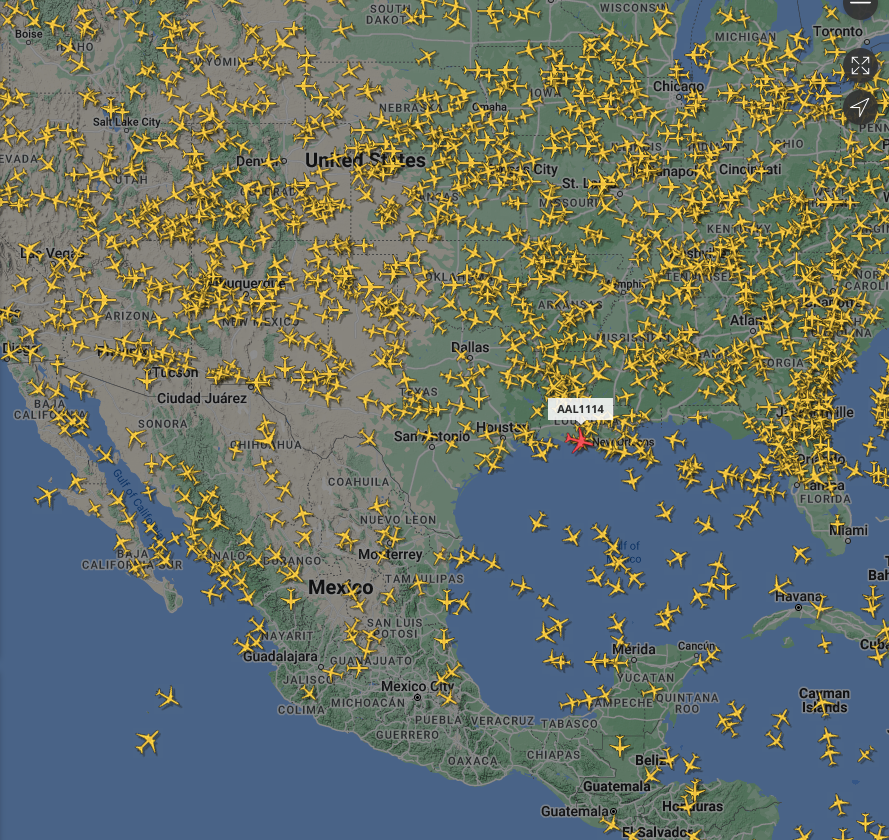Flightradar24 is a Swedish internet-based service that shows real-time aircraft flight tracking information on a map. It includes flight tracking information, origins and destinations, flight numbers, aircraft types, positions, altitudes, headings and speeds. (thanks, Wikipedia!)
Started as a hobby project, FlightRadar24 has the largest ADS-B (Automatic Dependent Surveillance-Broadcast) network in the world, with over 4,000 connected receivers. It tracks over 200k flights per day, which are watched by over 4 million users per day. It’s used by most major airlines and others in the aviation industry, including Airbus, Boeing, and Embraer.
Of course, those who use FlightRadar24 as part of their jobs see the interface on a totally different level than those who use it as a hobby. And even those well-versed hobbyists can run rings around those of us (yep, me too. I’m not the aviation geek in the family; that’s Joe’s job) who just like to watch the planes move, see what plane is going over our house at any given moment, etc.
If you’re using FlightRadar24 as part of your career, or have memorized every flight pattern in the U.S. (if not the world) simply because you wanted to or flew so many of them, you can stop reading now; you already know this ;-). But for the rest of us…
You probably have already experienced hovering over a plane and seeing it turning reddish orange.

What does a red plane on FlightRadar24 mean?
Before we tell you the answer, we need to explain about squawk codes.
What’s a squawk code?
From, not surprisingly, FlightRadar24:
Squawk codes are what air traffic control (ATC) use to identify aircraft when they are flying. They are unique four-digit numbers and range from 0000 to 7777; some of which are fixed values signifying specific scenarios, others being randomly generated by ATC.
Squawk codes came about as aviation became more popular. When there were only a few planes in the air, it was easy for ATC (well, once there WAS an ATC) to keep track of all the planes that were flying at once. But when there became too many to pay attention to at one time, ATC began generating a number for each plane in the sky, so it could be identified.
If you hover over an individual plane on FlightRadar24, besides turning the aforementioned orangish-red the plane’s squawk code for that flight will be shown (in this case, its squawk is 2797).
As a side note, if you click on the plane, you learn more about the individual flight (in this case, it’s American Airlines Airbus319, going from Chicago O’Hare to Pittsburgh. It left 29 minutes late and was scheduled to arrive 19 minutes late)
FUN FACT! The term “squawk code” came about during World War II, thanks to the code name “Parrot” of Great Britain’s early radar equipment. Read more about it here.
Anyway, although there are up to 4,096 possible usable codes between 0000 and 7777, there are 3 squawk codes that are used for emergencies. They can be transmitted by any aircraft with a transponder for a pilot to explain their emergency to ATC. They include:
Squawk 7500
This code is used to indicate that the aircraft has been hijacked, and, in turn, requires urgent emergency support from both ATC and available security services.
Squawk 7600
This code is used by the pilot to communicate to ATC that their aircraft has lost radio (read: verbal) communication with ATC. If radio contact can’t be established, planes will be instead directed using aviation light signals. These light signals can be used to provide aircraft with clearance to land or to indicate unsafe conditions in case radio contact fails.
Squawk 7700
Squawk 7700 is used when there’s an emergency onboard. The term “emergency” is used loosely and can be something as serious as an onboard fire or a passenger who is having a major medical event, or not quite so serious as perhaps the plane giving a warning message about the plane that’s something manageable).
So now that you’re an expert on squawk codes (those of you who REALLY understand squawk codes, yes, I know I’ve barely touched the surface. Again, this is just for Jamie Q. Public to get an idea of them), let’s go back to:
What does a red plane on FlightRadar24 mean?
If you see a red plane on FlightRadar24, it typically means the plane in question has put out a squawk code of 7500, 7600 or (most often) 7700.
Can you find out what’s happening on the plane?
At the time? No. I mean, if a plane is hijacked and it’s made the news, you may hear about it that way. But those are, obviously, very rare.
You can sometimes find out what’s happened after the fact, at least for some of the flights in question:
- The Aviation Herald publishes some of these events.
- For pilot reports to the NASA ASRS self-reporting safety system, you can search their database. If the pilot filed a report then you will see it show up there.
All photos: FlightRadar24
Want to comment on this post? Great! Read this first to help ensure it gets approved.
Want to sponsor a post, write something for Your Mileage May Vary, or put ads on our site? Click here for more info.
Like this post? Please share it! We have plenty more just like it and would love it if you decided to hang around and sign up to get emailed notifications of when we post.
Whether you’ve read our articles before or this is the first time you’re stopping by, we’re really glad you’re here and hope you come back to visit again!
This post first appeared on Your Mileage May Vary
Join our mailing list to receive the latest news and updates from our team.